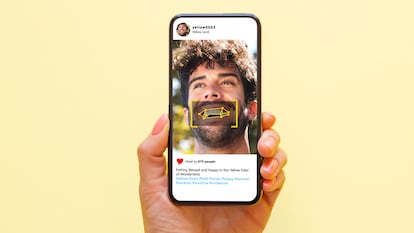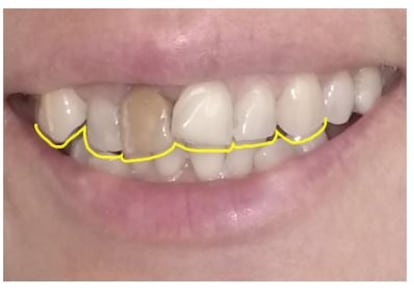How can a smile help identify the deceased?
Forensic anthropologists can now identify faces based on photos posted on social media

A smile captured in a photograph can help identify the deceased. This has been discovered in a study conducted by María Inmaculada Alemán Aguilera – Professor of Physical Anthropology at Spain’s University of Granada – and the Polish forensic anthropologists, Melania Mazur and Katarzyna Górka. The three women have published their findings in the academic journal Forensic Science International.
A photo of someone smiling allows said person to be identified… even if they die in an environment in which there is no access to a fingerprint database, or if their dental records and DNA profile are not available. The smile is essential, because this gesture exposes the incisor and canine teeth, both of which are fundamental to identifying a deceased person.
The outline of the upper incisors and canines in a photograph allows forensic specialists to compare the incisal line with human remains. This identification method has been put into practice with good results, in very difficult circumstances: over the last two years, this method has helped identify at least a dozen migrants, who drowned in the Mediterranean Sea en route to Europe. The impossibility of accessing medical or police databases in many developing countries means alternative identification methods are needed.

The work of forensic anthropologists, in recent years, has focused heavily on discovering alternative identification methods. The field revolves around the study of corpses that are hard to identify, either because they died a long time ago, or because they were found in difficult contexts, such as in a dictatorship, or along a migration route.
Alemán has worked with Egyptian mummies, Spanish Civil War exhumations and unidentified migrants.
“This type of identification always requires comparison. We always need something from before and after death,” she explains. The most reliable and common antemortem data includes dental records, fingerprints, or DNA.
“But [this data] is not always available. In many cases, moreover, these databases don’t even exist in the countries of origin of people who die during their migration,” she explains.
Three years ago, Alemán and her colleagues began researching new and unconventional identification methods. Photos on social media seemed like a good place to start.
“Right now, there are photos of just about everyone in the world that are easily accessible. Either because the person has posted them on Facebook or Instagram, or because they’ve sent them to friends or family.” In the case of migrants, before leaving, “many of them send photos to their acquaintances in Europe. This material is what we work with.”
The smiling photos – in addition to allowing the antemortem dental contour lines to be traced – also make it possible to find specific characteristics in the teeth. Damaged enamel, larger-than-normal spaces, etc. – all of this improves the reliability of identifying the deceased.
Alemán notes that this system is “still experimental,” but that, in practice, is already proving itself very useful. The study has shown that it achieves a positive identification rate of 82% and a “tolerable” identification rate of 11%, due to certain inconsistencies in a couple of teeth. In 7% of all cases, it was impossible to identify the deceased.
“At this time, these percentages are lower than those achieved with international protocols… dactyloscopy [fingerprints], dentistry and genetics are the only recognized ones. But, in many contexts, there is no other choice but to resort to alternative techniques.”
This new system has made it possible to ease the pain of many families. The Spanish anthropologist explains the process, which involves finding evidence of when the person was alive, which is not particularly difficult in these situations.
“Migrants usually come in groups and, more or less, we know when they leave and with whom. With that and the help of NGOs, we can reach out to the friends or relatives [of the deceased] who provide us with these images. Without them, it would be almost impossible… these people cannot be matched with their fingerprints, and it’s a major challenge to find a dentist who treated them and kept records,” Alemán says.
The Spanish and Polish researchers also want to understand how the type of lens used while taking photographs with a traditional camera can cause distortions in dental lines. Their study shows that certain deformations and curvatures occur, especially with wide angles. Fortunately, Alemán says, “practically all the photos used or published on social media are taken with cell phones.” She and her colleagues have verified that this results in no substantial alterations in the photographic results.
Tu suscripción se está usando en otro dispositivo
¿Quieres añadir otro usuario a tu suscripción?
Si continúas leyendo en este dispositivo, no se podrá leer en el otro.
FlechaTu suscripción se está usando en otro dispositivo y solo puedes acceder a EL PAÍS desde un dispositivo a la vez.
Si quieres compartir tu cuenta, cambia tu suscripción a la modalidad Premium, así podrás añadir otro usuario. Cada uno accederá con su propia cuenta de email, lo que os permitirá personalizar vuestra experiencia en EL PAÍS.
¿Tienes una suscripción de empresa? Accede aquí para contratar más cuentas.
En el caso de no saber quién está usando tu cuenta, te recomendamos cambiar tu contraseña aquí.
Si decides continuar compartiendo tu cuenta, este mensaje se mostrará en tu dispositivo y en el de la otra persona que está usando tu cuenta de forma indefinida, afectando a tu experiencia de lectura. Puedes consultar aquí los términos y condiciones de la suscripción digital.
More information
Últimas noticias
NASA discovers Titan doesn’t have an ocean, but a ‘slushy ice layer’ that increases possibility of life
Innocence lost in the forest of the child soldiers: ‘Each leader of the armed group had his girls’
‘Fallout’ or how the world’s largest company turned an anti-capitalist apocalyptic Western into a phenomenon
From inflation to defending migrants: Eileen Higgins and Zohran Mamdani inaugurate the new Democratic resistance against Trump
Most viewed
- ‘El Limones’ and the growing union disguise of Mexican organized crime
- Christian Louboutin: ‘Young people don’t want to be like their parents. And if their parents wear sneakers, they’re going to look for something else’
- The low-cost creative revolution: How technology is making art accessible to everyone
- ‘We are dying’: Cuba sinks into a health crisis amid medicine shortages and misdiagnosis
- A mountaineer, accused of manslaughter for the death of his partner during a climb: He silenced his phone and refused a helicopter rescue











































